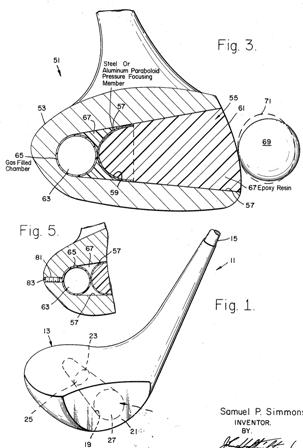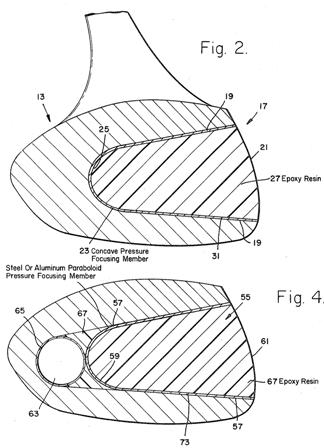Would it Work? A “Force Focusing Golf Club”
Time for a new addition to the “Would it Work” category of posts. Check out this “Force Focusing Golf Club” patent (USPN This is a golf club comprising a head and attached shaft wherein a pressure focusing means, such as a metal paraboloid reflector, is disposed in a filled recess to reflect shock waves caused by a golf ball impacting on the impact face of the head. The head may also include a gas-filled chamber adjacent to the side of the reflector opposite the impact face.


The patent goes on to explain:
With reference now to the drawings and more particularly to FIGS. 1 and 2, there is shown a golf club 11 having a head 13 and an attached shaft 15, the head comprising a tapered recess 17 having side walls 19 extending inwardly from an impact face 21 of the head 13. A pressure focusing means in the form of a focusing member 23 having a concave surface 25 is disposed in the recess 17 with the concave surface 25 facing the impact face 21. A synthetic material 27, such as an epoxy resin, is disposed in the recess 17 about the pressure focusing member 23 and fills the recess to the impact face 21.
.
.
.
The focusing member 23 may preferably be formed having a paraboloid shape and fabricated from a relative hard material such as sheet aluminum or steel or other metal. Also, the member 23 may include a skirt portion 31 extending toward the impact face 21 and lining the adjacent wall 19 as shown in FIG. 2, for example.
A golf ball, upon coming into a forceful contact with the impact face 21 of the head 13, causes pressure waves to propagate rearward through the head. Upon striking the reflecting member 23, however, much of this rearward moving force is reflected back toward the impact face 21 to generate a reverse thrust that will aid and add to the normal recovery memory of the synthetic material 27 and thus enhance the driving ability of the club.
By the use of the skirt member 31, the shock waves traveling rearward are concentrated more toward the focusing reflecting element 23 which will be thus even more effective in providing an aiding reverse thrust in the direction of proposed ball flight.With reference to FIG. 3, a golf club 51 is shown having a head 53 in which a recess 55, with side wall 57, is provided. The recess 55 may be deeper than the one shown in FIGS. 1 and 2 and a focusing member 57, having a concave surface 59, is disposed therein spaced from the end of the recess. Adjacent to the member 57 but on the side thereof opposite an impact face 61 is disposed a gas-filled chamber 63 having a non-rigid spherical wall 65. The gas may be ordinary air or an inert gas or mixture of gases at a predetermined pressure. The space between the chamber 63 and focusing member 57 and between the member 57 and the impact face 61 may be filled with a synthetic material 67 as has been previously described with reference to the embodiments of FIGS. 1 and 2.
In operation, a pressure shock wave is caused to travel through the synthetic filler material 67 when a golf ball 69 strikes the impact face 61 of the golf club head 53. This shock wave is to a great extent reflected by the focusing characteristic of the focusing member 57 back toward the impact face 61. However, a portion of the force exerted on the member 57 causes it to move toward the chamber 63 and pushes against the spherical wall 65 to thereby compress the gas therein.
Compression of the gas in the chamber 63 in turn causes a reverse reaction forcing the non-rigid wall 65 to push against the member 57. This reaction thus produces force waves to travel toward the impact face 61 through the material 67. The ball 69, which does not instantaneously leave the face 61 but rather deforms to an approximate shape seen by dashed outline 71 for a measurable period of time, not only receives the forces provided by the normal recovery memory of the synthetic filler material 67 as focused by the member 57, but also receives such forces in a magnified manner due to the compression factor of the chamber 63. In other words, the shock wave caused by the impact of the golf ball 69 travels toward the focusing member 57 which tends to concentrate the reverse force back toward the ball 69. Since the maximum reflected force and force caused by the compression of the gas within the chamber 63 occurs at the moment the ball begins its own recovery from its deformed configuration, the total reverse thrust effect will more than substantially lessen, if not eliminate, the loss of energy consumed in overcoming the inertia of the ball. This results in added velocity and distance of ball flight. This effect will be even further enhanced by providing a skirt member 73 as shown in FIG. 4 and described previously in connection with the embodiment of FIG. 2.
The wall 65 of the chamber 63 may be fabricated from a relatively thin plastic material such as commonly used to fabricate table tennis balls. Also, it should be noted that this chamber further acts as a counterbalance factor. By positioning this sealed spherical chamber at approximately the center of the club head, the weight of the head will be distributed on either side of the center line of the hitting area to provide for maximum efficiency and balance.
It may be advantageous under certain conditions to be able to adjust the amount of gas pressure present in the chamber 63. FIG. 5 illustrates a means whereby this may be accomplished. Here, a head similar to the one shown in FIG. 3 is shown to have a passage way 81 extending through the rear portion of the head from the chamber 63. A gas valve assembly 83, similar to a pneumatic tire valve, may be inserted in the passage 81 to allow gas pressure adjustment or even the changing of the gas or gases.
My prediction: not a chance that a “a metal paraboloid reflector… to reflect shock waves caused by a golf ball impacting on the impact face of the head” would have any influence on performance.
Dave Dawsey – The Golf Attorney
PS – Check out more “Would it Work?” posts HERE
